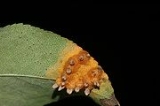
Gymnosporangium fuscum
Encyclopedia
Gymnosporangium sabinae (also Gymnosporangium fuscum and other names) (pear rust, European pear rust, or pear trellis rust) is a fungal
heteroecious
plant pathogen
with Juniperus (Juniper trees and shrubs) as the primary (telia
l) host and Pyrus (pear trees), Malus
(apple trees), or Crataegus
(hawthorn) as secondary (aecial
) hosts. It is one of many types of rust fungi
affecting plants.
Like many rust diseases, G. sabinae requires two different hosts to complete its life cycle from year to year. Juniper is the winter host and pear is the most common summer host. Spores (called ascospores or aeciospores
) are produced from the fungal lantern-shaped growths which protrude from the blisters on the underside of the pear leaf which become airborne and infect junipers. This fungus overwinters in swellings or galls on infected twigs and branches of susceptible juniper plants. In the spring after a rain or heavy dew, the galls on the juniper produce tiny dark horn-like growths that become covered with an orange-brown gelatinous mass called telia. The corresponding stage on the pear trees is known as aecia. The telia and aecia release wind borne resting or hibernating spores (called teliospore
s and aeciospores) capable of infecting susceptible pear leaves and Juniper respectively. Spores produced from the fungus-induced swellings on juniper stems can be infectious up to 6 km. The disease causes a yellow-orange spot that turns bright red on leaves of pear trees. The disease can be particularly damaging on pear, resulting in complete defoliation and crop loss if not treated. The fungus feeds on the living cells of the host plant and is not capable of surviving on dead plant material, and so must either alternate with a different host or produce resting spores to pass the dormant season. Pear rust is a regulated disease in some countries.
Fungus
A fungus is a member of a large group of eukaryotic organisms that includes microorganisms such as yeasts and molds , as well as the more familiar mushrooms. These organisms are classified as a kingdom, Fungi, which is separate from plants, animals, and bacteria...
heteroecious
Heteroecious
A heteroecious parasite is one that requires at least two hosts. The primary host is the host in which the parasite spends its adult life; the other is the secondary host. Both the primary host and an unrelated alternate host are required for the parasite to complete its life cycle...
plant pathogen
Phytopathology
Plant pathology is the scientific study of plant diseases caused by pathogens and environmental conditions . Organisms that cause infectious disease include fungi, oomycetes, bacteria, viruses, viroids, virus-like organisms, phytoplasmas, protozoa, nematodes and parasitic plants...
with Juniperus (Juniper trees and shrubs) as the primary (telia
Telia
Telia may refer to:*Telia - part of the reproductive cycle of Rusts*Telia Digital-tv - a Swedish TV platform*Telia, Nepal - a village in Nepal*TeliaSonera - a Swedish/Finnish telecom operator*Telia Challenge Waxholm - Golf tournament...
l) host and Pyrus (pear trees), Malus
Malus
Malus , the apples, are a genus of about 30–35 species of small deciduous trees or shrubs in the family Rosaceae. Other studies go as far as 55 species including the domesticated Orchard Apple, or Table apple as it was formerly called...
(apple trees), or Crataegus
Crataegus
Crataegus , commonly called hawthorn or thornapple, is a large genus of shrubs and trees in the rose family, Rosaceae, native to temperate regions of the Northern Hemisphere in Europe, Asia and North America. The name hawthorn was originally applied to the species native to northern Europe,...
(hawthorn) as secondary (aecial
Aecium
Aecium is a specialised reproductive structure found in some rusts and smuts which produces aeciospores. In some literature Aecia are also referred to as "cluster cups"....
) hosts. It is one of many types of rust fungi
Rust (fungus)
Rusts are plant diseases caused by pathogenic fungi of the order Pucciniales. About 7800 species are known. Rusts can affect a variety of plants; leaves, stems, fruits and seeds. Rust is most commonly seen as coloured powder, composed off tiny aeciospores which land on vegetation producing...
affecting plants.
Like many rust diseases, G. sabinae requires two different hosts to complete its life cycle from year to year. Juniper is the winter host and pear is the most common summer host. Spores (called ascospores or aeciospores
Ascospore
An ascospore is a spore contained in an ascus or that was produced inside an ascus. This kind of spore is specific to fungi classified as ascomycetes ....
) are produced from the fungal lantern-shaped growths which protrude from the blisters on the underside of the pear leaf which become airborne and infect junipers. This fungus overwinters in swellings or galls on infected twigs and branches of susceptible juniper plants. In the spring after a rain or heavy dew, the galls on the juniper produce tiny dark horn-like growths that become covered with an orange-brown gelatinous mass called telia. The corresponding stage on the pear trees is known as aecia. The telia and aecia release wind borne resting or hibernating spores (called teliospore
Teliospore
Teliospore is the thick-walled resting spore of some fungi , from which the basidium arises.-Development:They develop in telia ....
s and aeciospores) capable of infecting susceptible pear leaves and Juniper respectively. Spores produced from the fungus-induced swellings on juniper stems can be infectious up to 6 km. The disease causes a yellow-orange spot that turns bright red on leaves of pear trees. The disease can be particularly damaging on pear, resulting in complete defoliation and crop loss if not treated. The fungus feeds on the living cells of the host plant and is not capable of surviving on dead plant material, and so must either alternate with a different host or produce resting spores to pass the dormant season. Pear rust is a regulated disease in some countries.

